A.V. Kvasnikov. George Knight and scientist
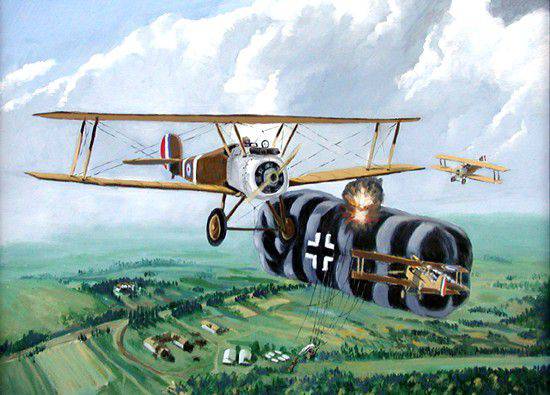
Alexander Vasilievich Kvasnikov (1892-1971), Honored Scientist and Technician of the RSFSR, laureate of the USSR State Prize, Doctor of Technical Sciences, Professor, was one of the leading Soviet scientists in the field of aircraft engine building, one of the creators of the theory of piston engines and the developer of complex heat power plants for various aircraft devices. "His whole life served as an example of selfless labor, honesty and demanding of himself and his students, burning in the implementation of new ideas aimed at improving and developing the theory and technology of aircraft engine building, with which he gave many years of his creative activity," Alexander Vasilyevich characterized him. student V.P. Belyakov.
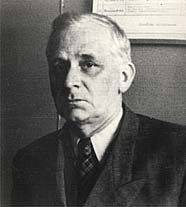 His merits in the field aviation and space industries are widely known in the world scientific community, but few people know that during the First World War Kvasnikov became a pioneer in the field of aviation jet weapons. He developed the world's first missile launcher for an airplane and deployed missiles in combat.
His merits in the field aviation and space industries are widely known in the world scientific community, but few people know that during the First World War Kvasnikov became a pioneer in the field of aviation jet weapons. He developed the world's first missile launcher for an airplane and deployed missiles in combat. Alexander Vasilyevich Kvasnikov was born on May 13 in Baku in the family of a turner of the mechanical workshop of the Nobel Brothers' Association in Baku. He received his primary education in a three-year city school and evening working school, after which he studied at the Baku Real School. In the summer, Alexander worked in the Nobel machine shops and graduated from the evening courses for workers located in the Black City. In the 1892 year, after graduating from college and an internship in the Volga Shipping Company, Kvasnikov entered the Moscow Technical College (later MVTU). In the first year he became interested in aviation, becoming a member of the aeronautical circle of Professor N.Ye. Zhukovsky. Together with A. Tupolev and V. Stechkin he participated in the construction and testing of the wind tunnel, studied the Magnus effect. A student Kvasnikov made a report on these works at the 1910-th All-Russian aeronautical convention in the spring of 3 in St. Petersburg, where he met K.E. Tsiolkovsky.
Immediately after the start of the First World War, Kvasnikov, interrupting his studies, enlisted as a volunteer in the army. 7 January 1915 of the year (in the new style) he was enlisted in the 7 company of 1 of the spare telegraph battalion as a volunteer (“hunter”) and seconded to the Khodynsk aeronautical school of the Moscow Society of Aeronautics, where under the direction of pilot BI He learned the Russian flight on the plane "Farman-4". The training was successful, as evidenced by his record: 14 March - assigning the rank of private soldier, 17 March - junior non-commissioned officer, 9 July - ensign, and 29 July he passed the exam in the program "Military Pilot".
In accordance with the received order, Kvasnikov was sent to the front in the Grenadier Aviation Squad of the 4 Army, based in the area of the city of Baranavichy. At that time, in the squadron, as a rule, there were six aircraft, five officers, and two pilots of a non-commissioned officer or rank and file. In addition, four observer pilots (officers) were seconded, carrying out aerial reconnaissance and aerial photography. The detachment had reconnaissance "Moran-parasols", so even before sending to the permanent duty station, Kvasnikov retrained to this aircraft. 26 September 1915, Ensign Kwasnikov, received a new aircraft and left for his unit. The main types of combat activity of the detachment, in which the young officer immediately joined, were reconnaissance, aerial photography, and the adjustment of artillery fire.
In September, 1916, at the request of the commander of the squadron of Lieutenant Smolyaninov A. Kvasnikov, was awarded the title "Military Pilot". From the beginning of 1916, he began to fly to bombard enemy targets. Regular use of aviation for the bombing began after the 4 Army developed an air attack on the German-captured Baranavichy station, where many trains with artillery, ammunition, manpower and equipment accumulated. To participate in the operation selected the best pilots from different squadrons. The pilots, and among them was the famous M.N. Yefimov, arrived with their planes. A compound of ten airplanes was headed by Captain Jungmeister. As a result of the raid, 55 bombs with a total weight of 26 pounds were dropped, which set fire to the barracks, station buildings, damaged railway tracks and trains. After this operation, the practice of forming temporary connections from the best pilots became routine. As part of one of these compounds under the command of V.A. Jungme 30 July 1916 of the year took part Kvasnikov.
"For the brilliant execution of the raid on the station Baranavichy", as stated in the order on the Western Front, all the participants in the raid were presented for awards. The fact that already at that time Kvasnikov was considered one of the best pilots of the Western Front is shown by a telegram from 8 of September 1916, sent to Aviakants by captain Strelnikov, who formed a temporary connection for the planned next raid: "Favor to send the appropriate pilots, preferably Grenadier Kvasnikov or eleventh Zherebtsova. "
In October, Kvasnikov was sent to the Odessa Aviation School for retraining on the Anade aircraft, due to the partial rearmament of the Grenadier detachment, and in the same month he flew to his own detachment. At the end of the same year, he mastered the single-seat fighter Newpore-11, produced by the Dux factory.
In January, 1917, Kvasnikov, was sent to the Sevastopol Aviation School to learn how to fly the Newport-17 fighter. In mid-February, A. Kvasnikov returned to the squadron with a new aircraft and again proceeded to combat sorties. Great trouble for our troops was delivered by German tethered aerostats, from which enemy artillery fire was adjusted, and movements of equipment and manpower were monitored. The height of the balloon was usually 600-1000. The difficulty in dealing with aerostats was to avoid barrage fire of anti-aircraft artillery when approaching it. But even if the plane managed to break through to the target, then the attack with a machine gun fire was ineffective. The reasons for this were the small damaging effect of the bullet on the shell of the balloon, a small supply of ammunition, the unreliability of the machine gun and the inconvenience of its reloading. After the whole clip was shot, the pilot replaced it, dropping a machine gun into the cockpit. It was extremely dangerous to do these operations under the fire of anti-aircraft guns, especially since for some time the pilot was distracted from control of the aircraft. Meanwhile, the damaged aerostat was lowered onto the ground, where, after sealing the holes, he was again in combat readiness.
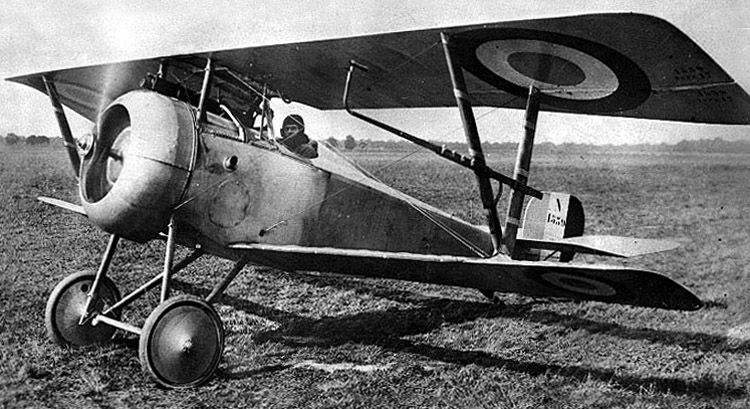
Ensign Kvasnikov, in addition to his main flight activity, was in charge of the technical part of his squad, being the most technically competent and inclined to work with the material part. Together with the mechanics, he refits machine-gun installations, manufactures and installs an optical sight on the aircraft, and oversees the maintenance of the various types of airplanes of the detachment in combat readiness. Thinking about increasing the effectiveness of aircraft in the fight against aerostats, Kvasnikov concluded that the most effective action against them should be missiles. Rocket production weapons in Russia it was established quite a long time ago, back in 1832 a pyrotechnic artillery school was established in St. Petersburg to train rocket specialists.
A major role in the development of missile weapons was played by the famous Russian artillery major general KI. Konstantinov, who later headed the Nikolaev Rocket Plant, serially producing various types of missiles (signal, lighting, incendiary, combat with a grenade, high-explosive combat, etc.). In fairness, we note that the idea of using missiles as an aviation weapon was not new. Kvasnikov went his own way, based on the poor possibilities of the front-line aircraft repair shops, which, as a rule, lacked spare parts for aircraft and engines. He developed an original and simple rocket launcher and, with the help of mechanics, mounted it on his Newpore-17. On the wing racks of the aircraft, four metal tubes for rockets were attached at a certain angle. Incendiary missiles, widely used in the army, were used as combat weapons. Shooting was carried out by a volley of a pair of rockets (left and right).
In the middle of August 1917, Ensign Kvasnikov at the Newport-17 fighter equipped with a launcher, flew over the front line at high altitude and, first diving at a German aerostat, fired missiles at the target for the first time. The balloon shell flared and it crashed to the ground. Unfortunately, the exact date of this event is unknown, since Kvasnikov’s handwritten report on the sortie and the destruction of the enemy aerostat was not found in the archives. However, in the report of the commander of the 2 Aviation Division from 23 in August 1917, it was noted, in particular: "It is advisable to return Newpore-17 to Ensign Kvasnikov, who burned German sausage on it and is generally distinguished by dashingness and courage."
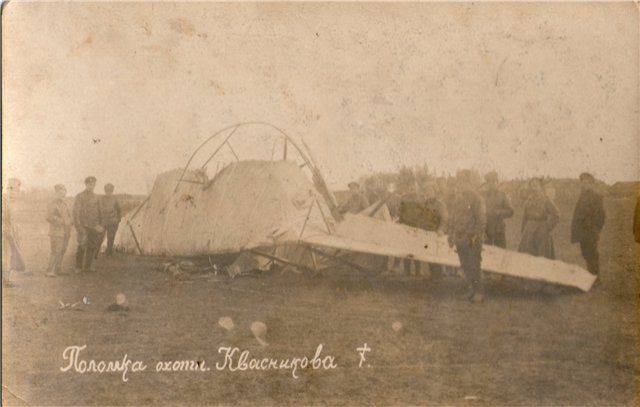
The fact is that A. Kvasnikov was punished for this combat mission: he was taken away of the plane and suspended from flying. Paradoxically, but the military bureaucrats punished the pilot, for the first time in the world, shot down an enemy aerostat with rockets, for "violating existing regulations and instructions." In contrast to the bureaucratic command, the pilots immediately appreciated Kvasnikov’s invention, the aircraft of other units began to be equipped with rocket launchers. And the first to repeat the experience of Kvasnikov, Ensign Kaminsky, who destroyed the second German aerostat in September on 1917 of the year at the Newpore-21. For military distinctions A. Kvasnikov was awarded four orders, demobilized from the army in November 1917.
Immediately after the demobilization of Kvasnikov to complete higher education, he enters the 5 course of the Tomsk Institute of Technology, which he graduated in December of 1918. Since January 1920, A.V. Kvasnikov works as a teacher at the same institute, and since 1922 of the year - head of the department of "Thermal Machines", giving lectures on technical thermodynamics and on internal combustion engines, is seeking to organize the specialty "Aircraft engines".
Works AV Kvasnikov on the dynamics of piston machines served as the basis for awarding him the title of professor in 1927. In the student group organized by him in 1932, they built the engine and the first Siberian aeronautical aircraft "STI-1".
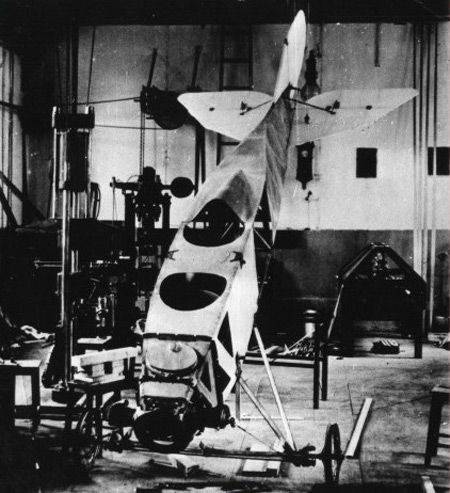
In 1931, Professor Kvasnikov, together with a group of staff and students, is transferred to the newly created Moscow Aviation Institute, where he forms the chair of the theory of aircraft engines and becomes its leader. In the prewar years, Alexander Vasilievich wrote a number of original textbooks on the theory of elements of an aircraft power plant: an ideal piston compressor, a workflow and methods for regulating a turbo compressor, a workflow of a gas turbine on engine exhaust gases, etc. In the same period, the theory of combustion was developed under his leadership gasoline-air mixtures in the engine cylinder and, in particular, the theory of detonation and ways to deal with it. During the Great Patriotic War, all areas of theoretical and experimental work of his team were determined by the needs of front-line aviation. In 1945, Professor Kvasnikov was awarded the title "Honored Worker of Science and Technology of the RSFSR".
After the war, he published the work "The altitude characteristics of a gas turbine compressor," which played a large role in the development of turbo-charged aircraft engines. Under his leadership, they created a number of original devices for studying processes in internal combustion engines, including the “MAI indicator” for recording variable pressure in an engine cylinder, which by its characteristics was superior to the domestic and foreign analogues that existed at that time.
Alexander Vasilyevich was one of the first scientists who saw and evaluated the prospects for using LRE in aviation and space technology. Trudy A.V. In the 1930s, Kvasnikov was widely used in GIRD in the development of methods for calculating thermal processes in the LRE. In 1959, he published the book The Theory of Liquid Rocket Engines, which dealt with general issues of the theory of liquid propellant rocket engines from the standpoint of thermodynamics and heat engineering. In it, he first proposed an engine workflow diagram, called the Kvasnikov cycle.
The range of scientific interests of Professor Kvasnikov was great: astronomy, problems of gravitational fields, interstellar mass and the use of solar sails in space, genetics, acoustics, color theory, etc. He initiated the creation of a laboratory of solar and radiant energy at the MAI, which, in particular, was engaged in development of low-power plants that convert solar energy into electrical energy.
In 1960, Kvasnikov creates the department of electric propulsion and power plants. For the development of a method for testing elements of high-powered rocket engines, he received the USSR State Prize. The role of Professor Kvasnikov in the Soviet higher education was great. He was in fact one of the spiritual leaders of the MAI during his forty years of work at the institute. Many of his students became professors, associate professors and teachers of the MAI, MSTU and other leading universities of the country, well-known designers. The well-known theorist of gas transport turbines, Yakov Aleksandrovich Spunde, wrote: “A. Kvasnikov was an encyclopedic educated person, an intellectual in the best sense of the word. Until the last days of his life, he deeply believed that the development of science would help not only to provide people with material benefits, but also contribute to a change for the better in their inner essence ... "
On his sixtieth birthday Alexander Vasilyevich said: “I have lived an interesting life. It began in Tsarist Russia, went through a great revolution ... I was born in a century of squeaky carts, saw the flights of the first aircraft, participated in the rapid development of aviation and live in a time when a huge future opens before humanity outside the atmosphere - I really want to see this future ... I know that I will be able to see it through the eyes of my sons, and in this I see my own little personal happiness. ”
Sources:
Nikolskaya M. "I have lived an interesting life" // Newspaper "Behind the scenes", 07.06.2012.
Neshkin M., Shabanov V. Aviators - Holders of the Order of St. George and St. George Weapons of the First World War 1914-1918. M: ROSSPEN, 2006. C. 217-219.
Rybalko V.V. The first exploits. The first air battles / Rybalko V.V., Shishov L.M. // Wings of the Motherland: Sat. articles. M .: DOSAAF USSR, 1983. C. 27- 37.
Kozyrev V., Kozyrev M. Missile salvo in the air. // Wings of the Motherland. 2000. No.4. C. 30-31.
Shchelokov A. About the forgotten Russian pilots. // Newspaper "Independent Military Review". 16.11.2007.
Shavrov V. History designs of aircraft in the USSR to 1938, Moscow: Mashinostroenie, 1985. C. 453.
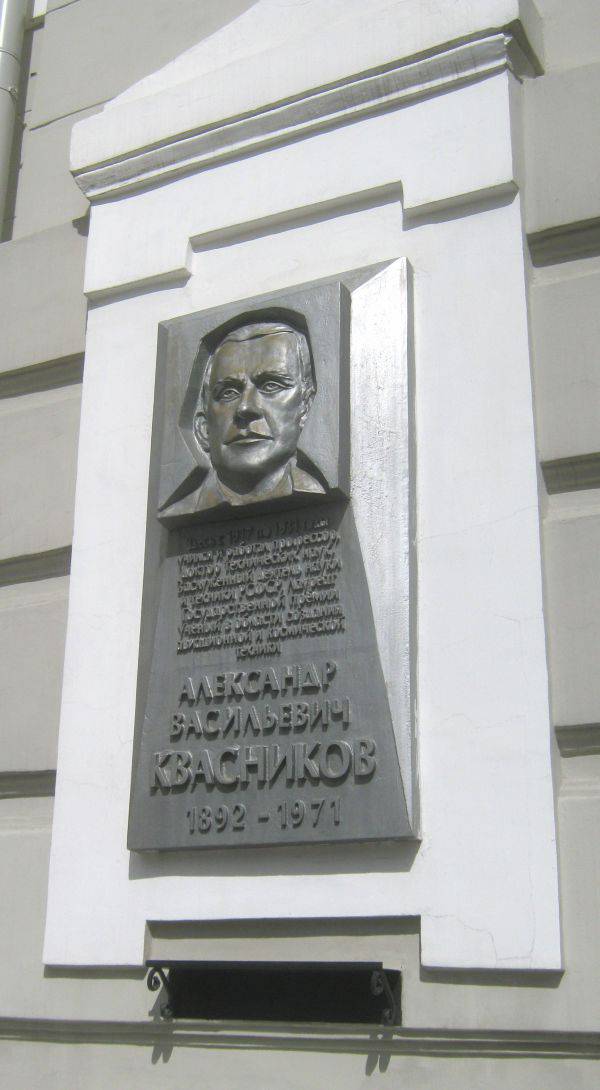
Information